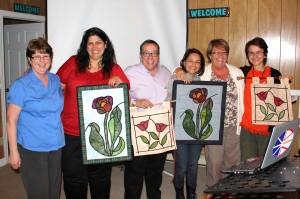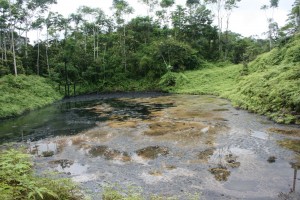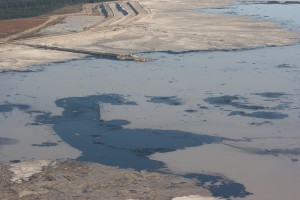Tailings Ponds: A Toxic Legacy for South Brook?
A dam breach in the tailings pond of the defunct Gullbridge copper mine in central Newfoundland has reinforced for me that all of our work here at KAIROS is connected. I often explain KAIROS in a kind of shorthand – we work for human rights and ecological justice. Sometimes those areas of work come together in unexpected ways.
Last June, my colleague Rachel and I traveled with KAIROS partners Lucy Talgieh of Wi’am in the Occupied Palestinian Territories and Claudia Castellanos Roncancio of the Organizacion Feminina Popular in Colombia to the town of South Brook, Newfoundland. As a Newfoundlander, it was a great joy for me to bring them there, and I knew what a warm welcome they would receive in this small community. Lucy, Claudia, and Rachel were deeply moved by South Brook’s welcome and response to their stories of struggle and hope in the face of systemic human rights abuses.

Lucy, Sara, Claudia, and Rachel (holding the quilted hangings we were given as thanks) with members of the South Brook community. Lucy’s and Claudia’s quilts feature the pitcher plant, an insectivorous plant that grows in boggy terrain, and which is the provincial flower of Newfoundland.
Now, South Brook is facing a water crisis, part of the resource extraction legacy of this part of the island. The 50-metre wide breach in the dam, which is 20 kilometres upstream from South Brook, may impact the town’s water supply. Tests for heavy metals and other toxic wastes are underway, with the results expected before Christmas. In the meantime, residents are being told not to consume the water in any way, and instead will be relying on bottled water into the New Year and possibly beyond.
The provincial environment minister, Tom Hedderson, told CBC that the boggy terrain between the tailings pond and the water supply would help: “There is 400 metres of bog between the dam and the river, and that’s where most of the tailings have ended up. It’s fortunate in a way, because that becomes a natural filter.”
In fact, that opens up a whole other set of ecological questions. A bog, like the muskeg of Northern Alberta that is potentially impacted by leaks from tar sands tailings ponds, is essentially a sponge upon which all kinds of life –insects, fish, amphibians, reptiles, birds, and mammals– depend. This bog and the waterways are connected to a salmon river. And in a province where people hunt and fish for food, all these species, human and non-human, are inter-connected. What affects one may eventually affect them all.
We don’t know what damage this breach will do to the ecosystem of this area or to South Brook’s water supply. It may be minor. But that’s really not the point. What we do know is that tailings ponds, whether they are close to a town like South Brook, a reserve in Northern Alberta, or an Indigenous community in Colombia, are a significant risk to ecosystems, water sources, and people.
We often talk about the terrible pollution that we see when we visit resource extraction sites overseas – tailings ponds from gold mines in the Philippines, or waste water ponds from oil extraction in Ecuador.
We remark on the tailings ponds of the Alberta tar sands, which are so large that they can be seen from space. Yet if we were fly low over Canada, we would see a landscape littered with tailings ponds, large and small – some of them manufactured, some of them natural ponds filled with waste.
Even when we are trying to make them safer –this dam was being repaired when it burst– tailings ponds remain a terrible legacy of resource extraction projects.
KAIROS remains concerned that changes to environmental assessment and protection laws in recent omnibus bills mean that situations like this will continue to occur in Canada. We also remain concerned about the lack of legislation holding Canadian resource extraction companies accountable for human rights and ecological abuses occurring in the course of their activities overseas. If you would like to learn more about our work in this area, please take a look and our new video and study guide, Remember the Land, and consider sharing it with your church or community.
Thankful for the kindness and generosity of the people of South Brook, KAIROS extends to them its hope that the immediate situation there may be resolved soon.






